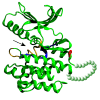c.1810C>T polymorphism of NTRK1 gene is associated with reduced survival in neuroblastoma patients
- PMID: 20003389
- PMCID: PMC2800120
- DOI: 10.1186/1471-2407-9-436
c.1810C>T polymorphism of NTRK1 gene is associated with reduced survival in neuroblastoma patients
Abstract
Background: TrkA (encoded by NTRK1 gene), the high-affinity tyrosine kinase receptor for neurotrophins, is involved in neural crest cell differentiation. Its expression has been reported to be associated with a favourable prognosis in neuroblastoma. Therefore, the entire coding sequence of NTRK1 gene has been analysed in order to identify mutations and/or polymorphisms which may alter TrkA receptor expression.
Methods: DNA was extracted from neuroblastomas of 55 Polish and 114 Italian patients and from peripheral blood leukocytes of 158 healthy controls. Denaturing High-Performance Liquid Chromatography (DHPLC) and Single-Strand Conformation Polymorphism (SSCP) analysis were used to screen for sequence variants. Genetic changes were confirmed by direct sequencing and correlated with biological and clinical data.
Results: Three previously reported and nine new single nucleotide polymorphisms were detected. c.1810C>T polymorphism present in 8.7% of cases was found to be an independent marker of disease recurrence (OR = 13.3; p = 0.009) associated with lower survival rates (HR = 4.45 p = 0.041). c.1810C>T polymorphism's unfavourable prognostic value was most significant in patients under 18 months of age with no MYCN amplification (HR = 26; p = 0.008). In-silico analysis of the c.1810C>T polymorphism suggests that the substitution of the corresponding amino acid residue within the conservative region of the tyrosine kinase domain might theoretically interfere with the functioning of the TrkA protein.
Conclusions: NTRK1 c.1810C>T polymorphism appears to be a new independent prognostic factor of poor outcome in neuroblastoma, especially in children under 18 months of age with no MYCN amplification.
Figures



References
-
- Nakagawara A. Neural crest development and neuroblastoma: the genetic and biological link. Prog Brain Res. 2004;146:233–42. - PubMed
Publication types
MeSH terms
Substances
LinkOut - more resources
Full Text Sources
Other Literature Sources
Medical

